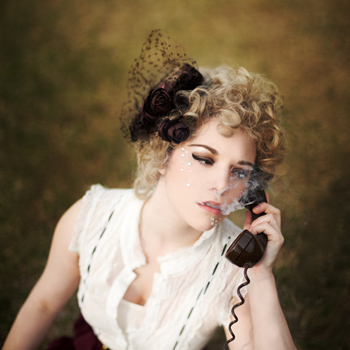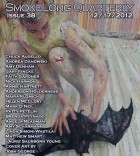What was the starting point of this story?
It’s interesting, this story didn’t begin how my stories normally do. Generally, I’ll get a voice in my head that’s repeating a sentence and then a paragraph (often times when my fiancée is telling me something of importance that I will later claim she never said,) then I start writing it down. If it goes somewhere, or exposes something/someone interesting, I’ll stay with it and hopefully it becomes a story.
With this story, though, I had a character in mind—a real person actually. I used to know this homeless guy named Darwin. I’d run into him outside of bars after close. He’d be holding his sign that said, “Why lie, I need money for beer,” and I’d trade him a regular cigarette for one he’d rolled. That was the extent of my charity, but I think he was fine with it. One time I sort of “came to” sitting against the front of a bookstore. I was sipping on a half pint of McCormick’s vodka and realized Darwin was sitting to my left and this other homeless guy, Ron, with three fingers missing from one of his hands, was on my right. Another time I was in detox and this younger guy was trying to take the plastic mat Darwin was sleeping on. A fight started, but I don’t remember how it ended. So, he and I had this weird, always coincidental, almost Déjà vu feeling, relationship during—needless to say—a very strange period in my life.
Anyway, so I imagined Darwin having to wash his clothes in a creek. That’s how it started.
You do a wonderful job creating this dark and dangerous (and cold) world. By the end of the piece, it’s pretty clear Mendel is doomed, and we don’t know how the efforts of the narrator and Karen will go. Did you imagine them past this piece? Do they survive?
Thanks for the compliment. Honestly, I’m getting a little anxiety thinking about the idea of my characters existing after the stories are over. Those poor, sad bastards. Maybe, if I ever get writer’s block, I’ll put together something about them all coexisting on an island, somewhere far out in the Universe where they can only do harm to each other. Let’s hope that never happens.
If I were to write this as a full length piece, not flash, I think the story would still start and end at the same places. I don’t think we’re ever intended to know what happens. Though, if I were to venture a guess, I would say Mendel is dead. Karen would stab him to death in the middle of the night with her “trench stick,” without consulting the narrator first. But she would then discover Mendel’s pistol was empty the whole time. However, the complete opposite could also happen—Mendel could get the best of the narrator and Karen—or they could all live happily ever after. This story is really about how humans react to fear. It’s such a primitive instinct, and it exists in all of us. The interesting thing about fear is there doesn’t have to be a real threat behind it. An empty threat, that can’t be proven to be empty, produces just as much fear as an actual threat.
Do your stories tend to be dark?
You know, that’s not really something I think about, but I guess most of them could (or would) be considered dark. Of course, it’s subjective. I don’t see them as particularly dark, and I’ve never set out to write a “dark” story. I write about subjects and people that interest me, and if you’re writing an honest story that has anything to do with people, at all, it will be, to some extent, dark, right? Even if you write a “silver lining” story, there still has to be something to put that silver lining on.
I suppose it just depends on where your imagination takes you. It’s not like you can control it. I want to write unique, interesting stories that entertain and hopefully make readers feel and/or think. When I get my characters to a place where I need to start throwing shit at them, I think, what could happen here that is interesting, unique, entertains and yet is still consistent with the character’s behaviors and the world around them. Generally, the best ideas I come up with are pretty messed up. Fortunately, the real world is pretty messed up, so I don’t think my stories ever seem too far-fetched. Disturbing, maybe, but not unrealistic—the truth in that statement, of course, being more disturbing that any work of fiction.
What is your approach to titles for flash pieces? Is it different than for longer pieces?
Yeah, you see how the story’s about fear and “Fear” is also in the title? That’s just how clever I am when it comes to titles. Maybe that’s not true, but I don’t consider them my strong suit, nor do I enjoy deciding on them. When I’m thinking about a title, first and foremost, I’m trying to not ruin the story. That probably sounds bad, but, in my opinion, a weak title can do more harm than a strong title can do good.
So, I suppose, I probably go about the whole process backwards: not what’s good for the story, but rather, what’s not bad for it. I’ll get a few floating around—using that logic—and then decide which one of those is best.
To answer your second question: no, I think it’s whatever feels best for the story, regardless of length. Though I do think the titles of my shorter pieces tend to be longer, for whatever that’s worth.



 The core workshop of SmokeLong Fitness is all in writing, so you can take part from anywhere at anytime. We are excited about creating a supportive, consistent and structured environment for flash writers to work on their craft in a community. We are thrilled and proud to say that our workshop participants have won, placed, or been listed in every major flash competition. Community works.
The core workshop of SmokeLong Fitness is all in writing, so you can take part from anywhere at anytime. We are excited about creating a supportive, consistent and structured environment for flash writers to work on their craft in a community. We are thrilled and proud to say that our workshop participants have won, placed, or been listed in every major flash competition. Community works.